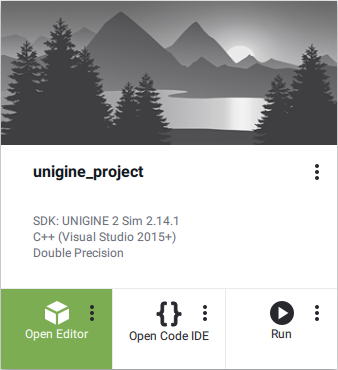UnigineEditor
UnigineEditor provides the core functionality for creation and editing of virtual worlds for UNIGINE-based applications based on the assets workflow. It allows you to easily view and modify virtual worlds by adding, transforming and editing the nodes.
In addition, UnigineEditor also provides:
- Customizable UI layout with dockable panels
- Integration with the Asset Browser
Editor Running#
Notice
You should keep UNIGINE SDK Browser launched to use UnigineEditor.
To launch UnigineEditor for your project, click Open Editor in the SDK Browser:

Articles in This Section
- Assets Workflow
- Settings and Preferences
- Editor Settings and Hotkeys
- World Settings
- Render Settings
- Screen
- Upscalers
- Visibility Distances
- Textures
- Lights
- Transparent
- Shadows
- Tessellation
- Global Illumination Settings
- Subsurface Scattering
- Dynamic Reflections
- Decals
- SSBevel
- SSDirt
- Landscape
- Terrain
- Water
- Clouds
- Vegetation
- Environment
- Occlusion Culling
- Camera Effects
- Color Correction
- Buffers
- Streaming
- Materials Quality
- Custom Post Materials
- Debug Materials
- Custom Composite Materials
- Wireframe Color
- Global Physics Settings
- Global Sound Settings
- Controls Settings
- Sandworm
- Using Editor Tools for Specific Tasks
- Making Cutscenes: Animations & Camera Control
- Capturing Screenshots and Frame Sequences
- Adding Variations for a More Realistic Environment
- Generating Impostors with Impostors Creator
- Editing Global Terrain
- Editing Landscape Terrain
- Batch Rename
- Mask Editor for Grass and Clutters
- Cluster Editor
- Texture Editor
The information on this page is valid for UNIGINE 2.19 SDK.
Last update:
2024-08-16
Help improve this article
Was this article helpful?
(or select a word/phrase and press Ctrl+Enter)